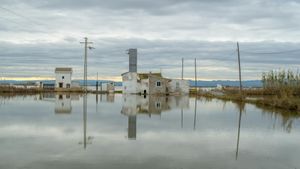The return of SpaceX's Crew-8 mission marked another significant milestone for the private aerospace company, as its astronauts touched back down on Earth after completing their exploration at the International Space Station (ISS). This mission's safe landing reflects SpaceX's commitment to reliable crewed spaceflight, which has become increasingly important as various space programs vie for attention and investment.
On the fateful day of their return, the Crew Dragon capsule, named Endeavour, executed its re-entry procedures flawlessly. At around 4:51 p.m. EDT, astronauts commanded the craft to descend from its low Earth orbit, initiating the long-awaited homecoming. The atmosphere bristled with excitement and apprehension as both mission control and families of the astronauts held their breaths. After maneuvering through the dense atmosphere, the capsule deployed its parachutes over the Atlantic Ocean off the coast of Florida.
"It feels great to be back on Earth! We had such amazing experiences at the ISS," exclaimed mission commander, Jasmin Moghbeli, during the debriefing right after landing.
Having launched the Crew-8 mission from Kennedy Space Center about six months prior, the astronauts had successfully completed numerous experiments, maintenance tasks, and technology demonstrations during their stay aboard the ISS. The collaborative effort put forth by NASA and international partners underscored the importance of maintaining human presence and continuous research aboard the station.
Principal mission scientist, Thomas Marshburn, stated, "Crew-8 has pushed the boundaries of our scientific knowledge and enhanced our connections with global partners. These missions are not only about human spaceflight; they also facilitate groundbreaking research. The data we've collected can offer insights applicable on Earth and beyond."
Upon their return, Moghbeli was joined by fellow astronauts Shannon Walker, European Space Agency’s Andreas Mogensen, and NASA's David Saint-Jacques. Each one had their unique experiences and contributions during the mission, showcasing the diversity and expertise of the crew.
The Crew-8's main goal was to support sustained research and development aboard the International Space Station. They participated actively in over 250 individual experiments, some focusing on bioregenerative life support systems and materials processing, which can develop life-saving applications for future explorations on the Moon and Mars.
One notable experiment conducted during Crew-8 was related to growing plants in microgravity conditions, aimed at establishing sustainable food sources for long-term space missions. Their preliminary results indicate broad prospects for developing efficient agricultural systems, potentially allowing future astronauts to cultivate their food as they venture to other planets.
SpaceX’s ability to safely return its astronauts fosters confidence not just among NASA but also among international partners, such as the European Space Agency and the Japanese Aerospace Exploration Agency, who play pivotal roles in collaborative space missions. The successful conclusion of Crew-8 signals to global leaders the advantages of investment in commercial space operations.
"This isn't just about sending humans to space; it’s about building the infrastructure needed for future human exploration beyond low Earth orbit," commented Bill Nelson, NASA's administrator. "Partnerships with private companies like SpaceX are reshaping our approach to space exploration."
The involvement of commercial entities is inherently changing the narrative surrounding space missions. Fostering healthy competition within the aerospace sector could lead to accelerated advancements. The collaboration between SpaceX and national agencies exemplifies how the future is being forged by blending public aspirations with private innovation.
While Crew-8 has now returned, it sets the stage for future missions, including Crew-9 and other planned explorations, which strive for the International Space Station's expeditions to be as routine as international flights. Looking down the road, NASA estimates it may soon see commercial providers spearheading missions to destinations previously dominated by governmental spaceflight.
Before the Crew-8 mission, astronauts were reliant solely on government-led missions for their trips to the ISS. With the dawn of private space travel obliging these entities to work side by side, NASA has been able to allocate more resources and focus on long-term exploratory objectives rather than transport logistics.
Following the Crew-8 mission's success, it’s pivotal to continue efforts toward enhancing and developing technologies, such as life-support systems and regenerative resource utilization, which facilitate self-sufficiency on extended missions. Space agencies globally are now discussing frameworks for future missions which embrace innovative strategies encompassing artificial intelligence for crew analysis and research management operations.
Training is also expected to evolve, reflecting the shift from predominantly governmental spaceflight to commercial companies taking on human crew responsibilities. Program directors are anticipating the call for programs to support civilian astronauts as commercial space travel opens doors to wider public participation.
Post-mission debriefings revealed the crew's enthusiasm for sharing their experiences with educational institutions, inspiring new generations to dream about seeking careers relating to science, technology, engineering, and mathematics (STEM). Moghbeli stated, "Our experiences up there are what makes all the hard work worth it. We hope to continue inspiring kids to look up to the stars and challenge them to reach for their dreams."
The successful return of Crew-8 serves as not just another achievement for SpaceX, but also as evidence of the rapidly transforming paradigm of space exploration. The mission highlights the increasing importance of commercial partnerships, advanced technologies, and active international collaboration to achieve ambitious goals beyond our Earthly confines.
Looking to the future, there’s no denying the reinforcement of cross-industry partnerships to sustain progress. SpaceX's achievement today could very well serve as the blueprint for exploration missions of tomorrow, which continue to expand our frontiers. The skies may be the limit, but as Crew-8 demonstrated, there is perhaps much more waiting to be discovered beyond.



